rear view mirror CADILLAC ELDORADO 1993 10.G Owners Manual
[x] Cancel search | Manufacturer: CADILLAC, Model Year: 1993, Model line: ELDORADO, Model: CADILLAC ELDORADO 1993 10.GPages: 398, PDF Size: 20.66 MB
Page 125 of 398
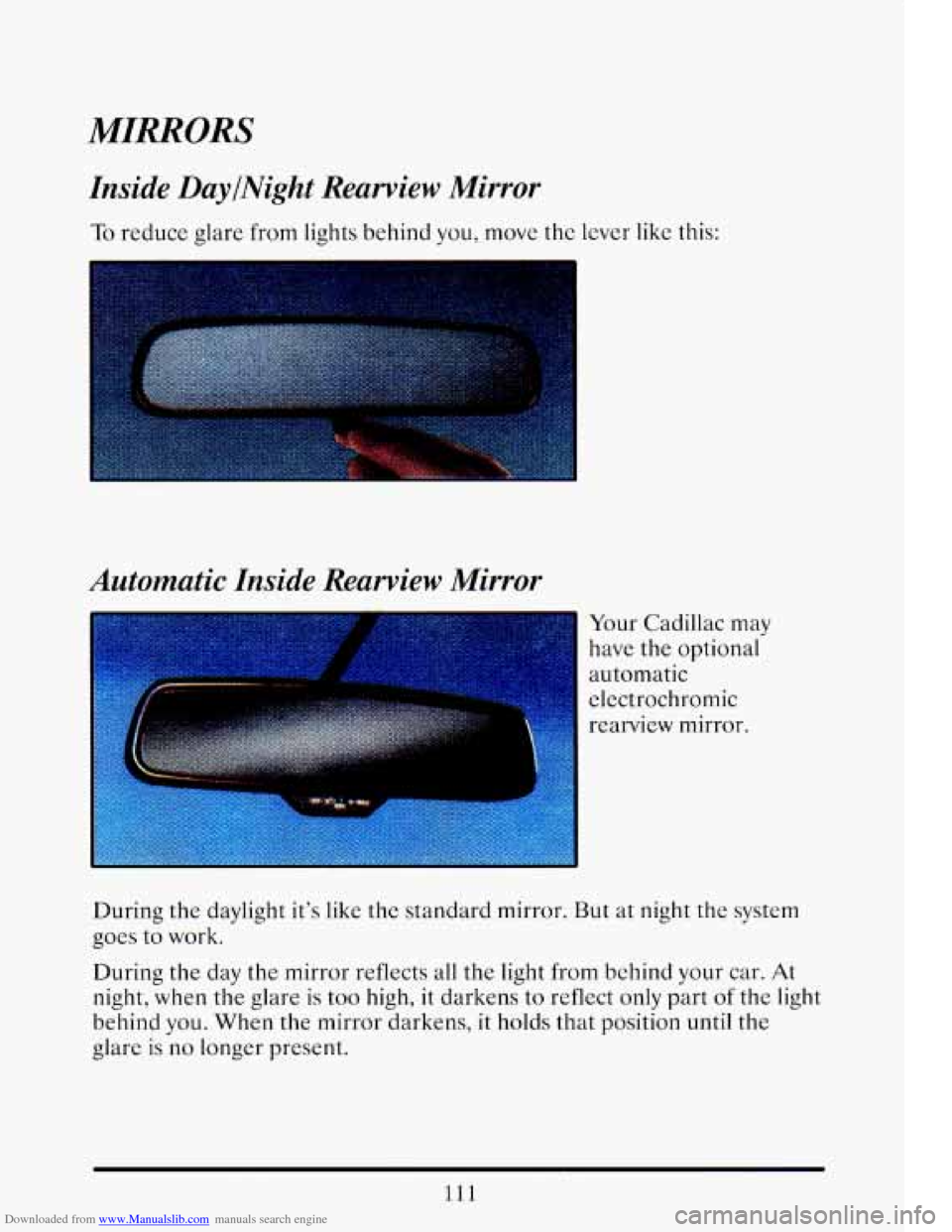
Downloaded from www.Manualslib.com manuals search engine MIRRORS
Inside DaylNight Rearview Mirror
To reduce glare from lights behind you, move the lever like this:
Automatic Inside Rearview Mirror
Your Cadillac may
have the optional
automatic
electrochromic
rearview mirror.
During the daylight it’s like
the standard mirror. But at night the system
goes to work.
During the day
the mirror reflects all the light from behind your car. At
night,
when the glare is too high, it darkens to reflect only part of the light
behind
you. When the mirror darkens, it holds that position until the
glare
is no longer present.
111
Page 126 of 398
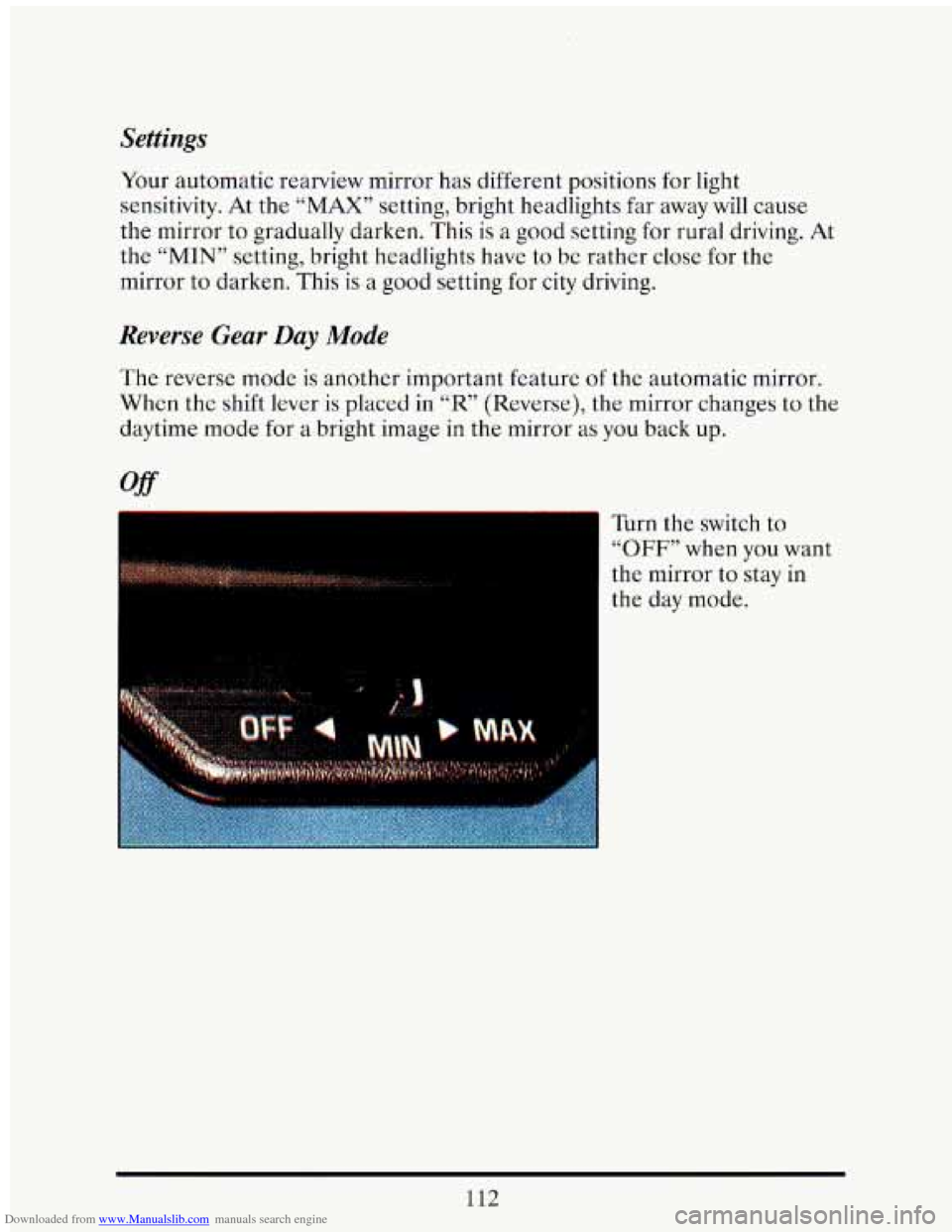
Downloaded from www.Manualslib.com manuals search engine Settings
Your automatic rearview mirror has different positions for light
sensitivity. At the
“MAX” setting, bright headlights far away will cause
the mirror
to gradually darken. This is a good setting for rural driving. At
the
“MIN” setting, bright headlights have to be rather close for the
mirror to darken.
This is a good setting €or city driving.
Reverse Gear Day Mode
The reverse mode is another important feature of the automatic mirror.
When the shift lever is placed
in “R’ (Reverse), the mirror changes to the
daytime mode
for a bright image in the mirror as you back up.
~ Turn the switch to
“OFF” when you want
the day mode.
....e >: . :.._ ..., the mirror to stay in X.<.,?.# ,. , .j ;.c.,c<- *_,i iil .. , .:: .. , .
.. .
112
Page 128 of 398

Downloaded from www.Manualslib.com manuals search engine Power Remote Control Mirrors
The control on the driver’s door armrest operates both outside rearview
mirrors. Move the center
switch to the left to select the driver side mirror,
or to the right
to select the passenger side mirror. Then press the control
pad to adjust each mirror
so that you can just see the side of your vehicle.
To lock the controls leave the selector switch in the middle position.
When
you operate the rear window defogger, it also warms both outside
mirrors
to help clear them of fog or ice.
CONVEX OUTSIDE MIRROR
Your right side mirror is convex.
A convex mirror’s surface is curved so you can see more from the driver’s
seat.
114
Page 130 of 398
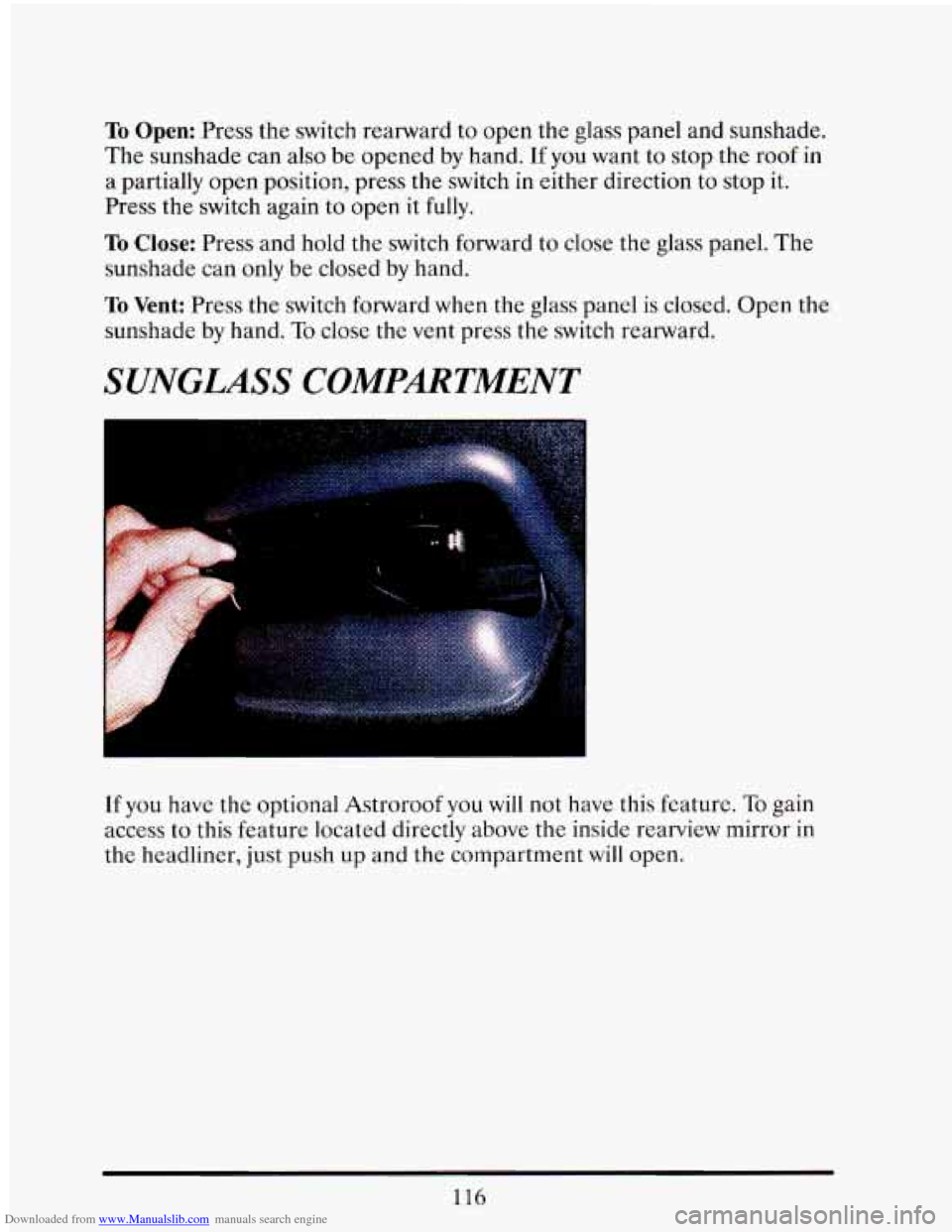
Downloaded from www.Manualslib.com manuals search engine To Open: Press the switch rearward to open the glass panel and sunshade.
The sunshade can also be opened by hand. If you want to stop the roof in
a partially open position, press the switch in either direction to stop it.
Press the switch again to open it fully.
To Close: Press and hold the switch forward to close the glass panel. The
sunshade can only be closed by hand.
To Vent: Press the switch forward when the glass panel is closed. Open the
sunshade by hand.
To close the vent press the switch rearward.
SUNGLASS COMPmTMENT
If you have the optional Astroroof you will not have this feature. To gain
access
to this feature located directly above the inside rearview mirror in
the headliner, just push up and the compartment will open.
116
Page 162 of 398
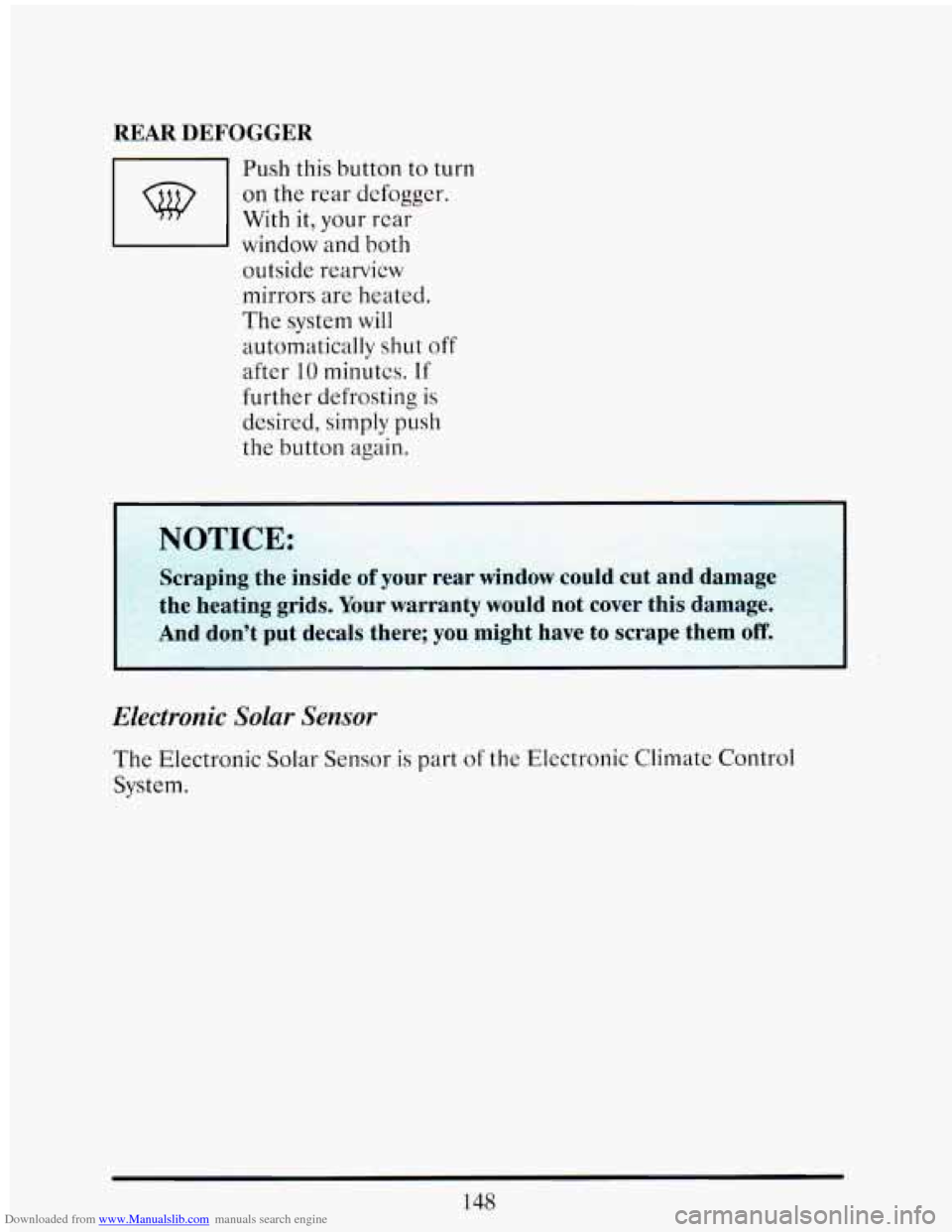
Downloaded from www.Manualslib.com manuals search engine REAR DEFOGGER
Push this button to turn
on the rear defogger.
With it, your rear
window and both
outside rearview
mirrors are heated.
The system will
automatically shut off
after
10 minutes. If
further defrosting is
desired, simply push
the button again.
“‘OTICE:
Scraping the inside of your rear window could cut and damage
the heating grids.
Your warranty would not cover this damage.
And don’t put decals there;
you might ha1 ocrap hem off.
L
Electronic Solar Sensor
The Electronic Solar Sensor is part of the Electronic Climate Control
System.
148
Page 203 of 398
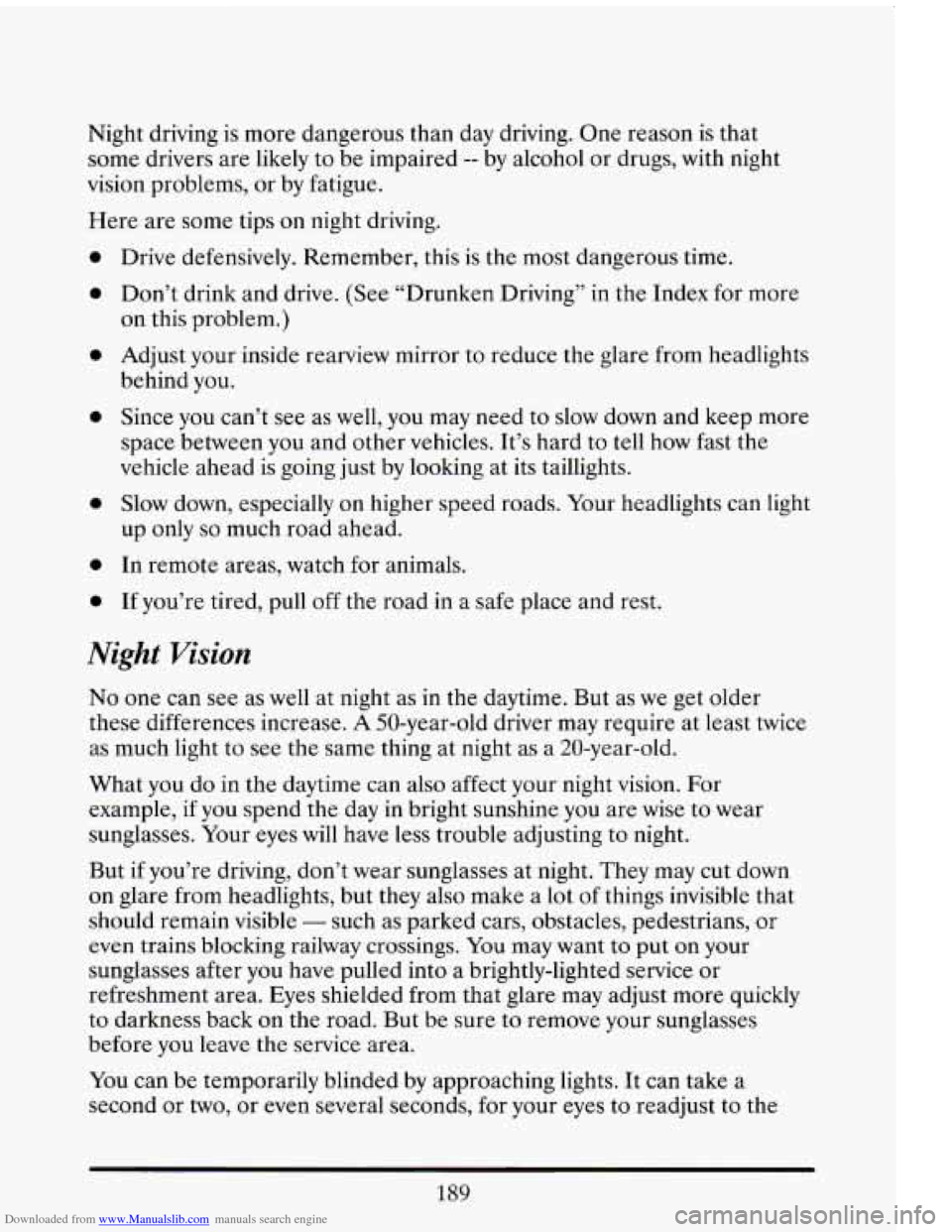
Downloaded from www.Manualslib.com manuals search engine Night driving is more dangerous than day driving. One reason is that
some drivers are likely to be impaired
-- by alcohol or drugs, with night
vision problems, or by fatigue.
Here are some tips on night driving.
0
0
0
0
0
0
0
Drive defensively. Remember, this is the most dangerous time.
Don’t drink and drive. (See “Drunken Driving” in the Index for more
on this problem.)
Adjust your inside rearview mirror to reduce the glare from headlights
behind you.
Since you can’t see as well, you may need to slow down and keep more
space between you and other vehicles. It’s hard to tell how fast the
vehicle ahead is going just by looking at its taillights.
Slow down, especially on higher speed roads. Your headlights can light
up only
so much road ahead.
In remote areas, watch
for animals.
If you’re tired, pull off the road in a safe place and rest.
Night Vision
No one can see as well at night as in the daytime. But as we get older
these differences increase.
A 50-year-old driver may require at least twice
as much light to see the same thing
at night as a 20-year-old.
What you do in the daytime can
also affect your night vision. For
example, if you spend the day
in bright sunshine you are wise to wear
sunglasses. Your eyes will have
less trouble adjusting to night.
But if you’re driving, don’t wear sunglasses at night. They may cut down
on glare from headlights, but they also make a lot
of things invisible that
should remain visible
- such as parked cars, obstacles, pedestrians, or
even trains blocking railway crossings. You may want to put on your
sunglasses after you have pulled into a brightly-lighted service or
refreshment area. Eyes shielded from that glare may adjust more quickly
to darkness back on the road. But be sure to remove your sunglasses
before you leave the service area.
You can be temporarily blinded by approaching lights. It can take a
second or
two, or even several seconds, for your eyes to readjust to the
189
Page 212 of 398

Downloaded from www.Manualslib.com manuals search engine Switch on your turn signal, check your rearview mirrors as you move
along, and glance over your shoulder as often as necessary.
Try to blend
smoothly with the traffic flow.
Driving on the Freeway
Once you are on the freeway, adjust your speed to the posted limit or to
the prevailing rate
if it’s slower. Stay in the right lane unless you want to
pass.
If you are on a two-lane freeway, treat the right lane as the slow lane
and the left lane as the passing lane.
If you are on
a three-lane freeway, treat the right lane as the slower-speed
through lane, the middle lane as the higher-speed through lane,\
and the left lane as the passing lane.
Before changing lanes, check your rearview mirrors. Then use your turn
signal.
Just before you leave the lane, glance quicklyover your shoulder to make
sure there isn’t another vehicle in your “blind” spot.
If you are moving from an outside to a center lane on a freeway having
more than two lanes, make sure another vehicle isn’t about to move into
the same spot. Look at the vehicles two lanes over and watch for telltale
signs: turn signals flashing, an increase
in speed, or moving toward the
edge
of the lane. Be prepared to delay your move.
Once you are moving on the freeway, make certain you allow
a
reasonable following distance. Expect to move slightly slower at night.
Leaving the Freeway
When you want to leave the freeway, move to the proper lane well in
advance. Dashing across lanes at the last minute
is dangerous. If you miss
your exit do not, under any circumstances, stop and back up. Drive on to
the next
exit.
At each exit point is a deceleration lane. Ideally it should be long enough
for you to enter it at freeway speed (after signaling,
of course) and then
do your braking before moving onto the exit ramp. Unfortunately, not all
deceleration lanes
are long enough -- some are too short for all the
braking. Decide when to start braking.
If you must brake on the through
lane, and if there is traffic close behind you, you can allow a little extra
Page 215 of 398

Downloaded from www.Manualslib.com manuals search engine Then here are some tips:
0
0
0
0
Make sure your vehicle is well ventilated, with a comfortably cool
interior.
Keep your eyes moving. Scan
the road ahead and to the sides. Check
your rearview mirrors frequently and your instruments from time
to
time. This can help you avoid a fixed stare.
Wear good sunglasses in bright light. Glare can cause drowsiness. But
don’t wear sunglasses at night.
They will drastically reduce your
overall vision at the very time you need all the seeing power
you have.
If you get sleepy, pull
off the road into a rest, service, or parking area
and take a nap, get some exercise, or both. For safety, treat drowsiness
on the highway as an emergency.
As in any driving situation, keep pace with traffic and allow adequate
following distances.
HILL AND MOUNTMN ROADS
J
Driving on steep hills or mountains is different from driving in flat or
rolling terrain.
201
Page 390 of 398
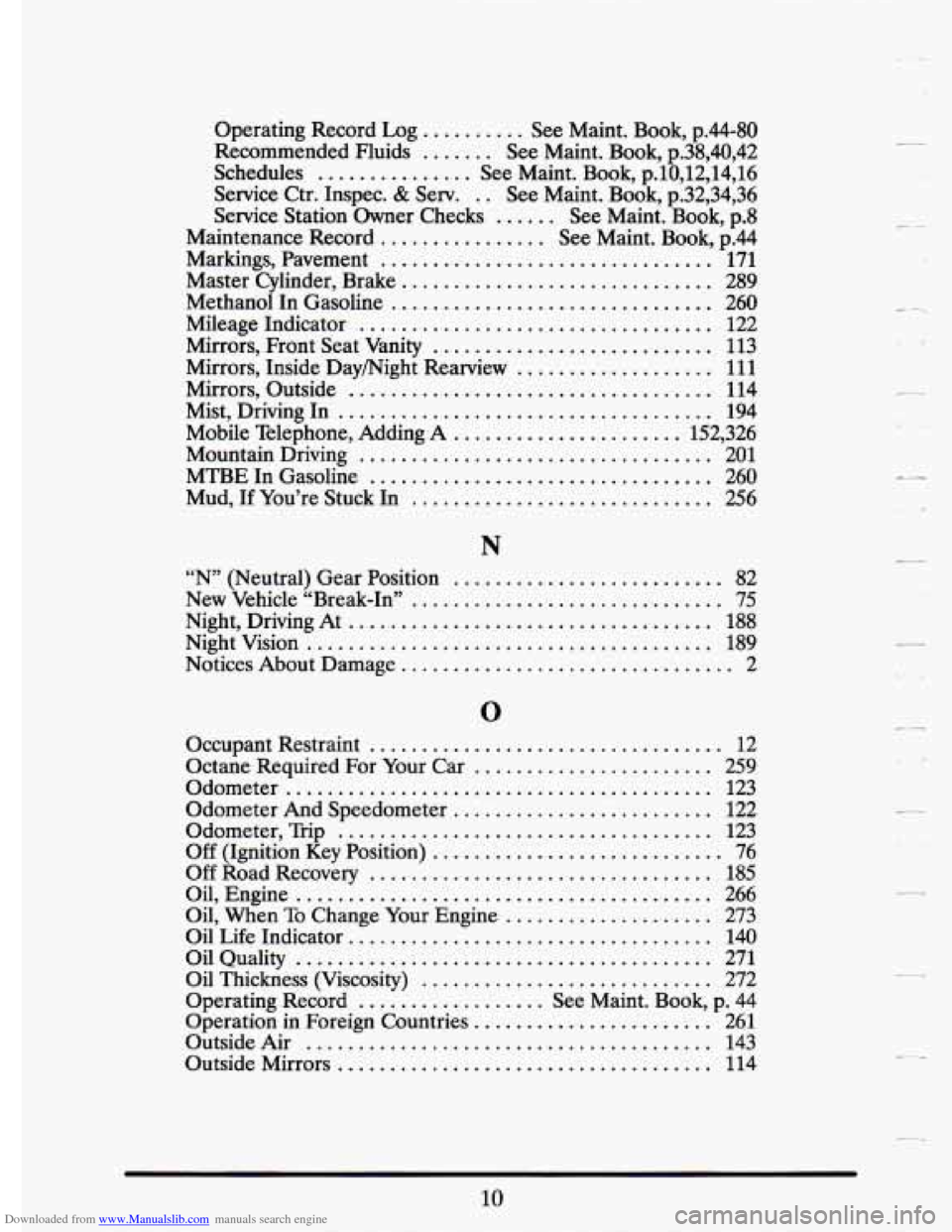
Downloaded from www.Manualslib.com manuals search engine .
Operating Record Log .......... See Maint . Book. p.44-80
Recommended Fluids ....... See Maint . Book. p.38,40,42
Service Ctr . Inspec . & Sew ... See Maint . Book. p.32,34,36
Schedules ............... See Maint . Book. p.10,12,14,16
Service Station Owner Checks ...... See Maint . Book. p.8
Maintenance Record ................ See Maint . Book. p.44
Markings. Pavement ................................ 171
Master Cylinder. Brake .............................. 289
Methanol In Gasoline ............................... 260
Mileage Indicator .................................. 122
Mirrors. Inside Daymight Rearview ................... 111
Mirrors. Outside ................................... 114
Mist. Driving In .................................... 194
Mobile Telephone. Adding A ...................... 152. 326
Mountain Driving .................................. 201
MTBE In Gasoline ................................. 260
Mud. If You’re Stuck In ............................. 256
Mirrors. Front Seat Vanity ........................... 113
N
“N” (Neutral) Gear Position .......................... 82
New Vehicle “Break-In” .............................. 75
Night. Driving At ................................... 188
Night Vision ....................................... 189
Notices About Damage ................................ 2
.
.I
..
LA
..
LA
.
0
Occupant Restraint .................................. 12
Octane Required For Your Car ....................... 259
Odometer ......................................... 123
Odometer And Speedometer ......................... 122
Odometer. Trip .................................... 123
Off (Ignition Key Position) ............................ 76
Off Road Recovery ................................. 185
Oil. Engine ........................................ 266
Oil. When To Change Your Engine .................... 273
Oil Life Indicator ................................... 140
Oil Quality ........................................ 271
Oil Thickness (Viscosity) ............................ 272
Operating Record .................. See Maint . Book. p . 44
Operation in Foreign Countries ....................... 261
OutsideAir ....................................... 143
Outside Mirrors .................................... 114
.
L-
c-
..
.
...
10